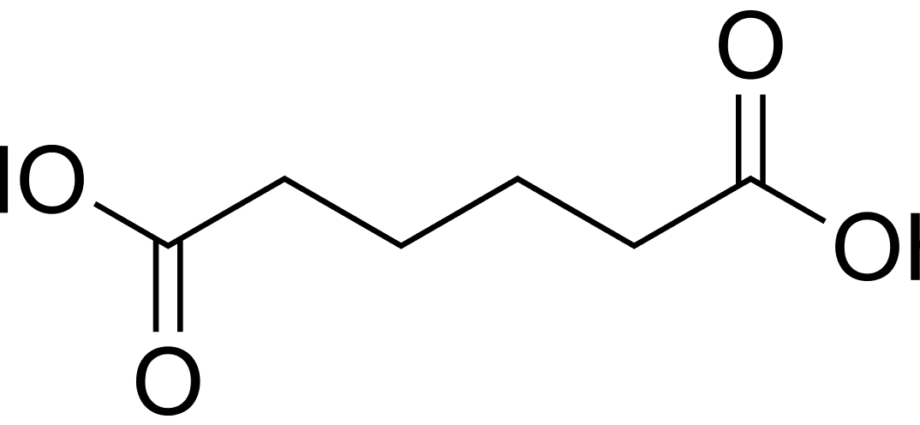Contents
About 3 million tons of adipic acid are produced annually. About 10% is used in the food industry in Canada, EU countries, the USA and many CIS countries.
Foods rich in adipic acid:
General characteristics of adipic acid
Adipic acid, or as it is also called, hexanedioic acid, is an E 355 food supplement that plays the role of a stabilizer (acidity regulator), acidifier and baking powder.
Adipic acid is in the form of colorless crystals with a sour taste. It is produced chemically by the interaction of cyclohexane with nitric acid or nitrogen.
A detailed study of all properties of adipic acid is currently underway. It was found that this substance is low-toxic. Based on this, the acid is assigned to the third safety class. According to the State Standard (dated January 12.01, 2005), adipic acid has a minimal harmful effect on humans.
It is known that adipic acid has a positive effect on the taste of the finished product. It affects the physical and chemical properties of the dough, improves the appearance of the finished product, its structure.
Used in the food industry:
- to improve the taste and physical and chemical characteristics of finished products;
- for longer storage of products, to protect them from spoilage, is an antioxidant.
In addition to the food industry, adipic acid is also used in light industry. It is used for the production of various man-made fibers, such as polyurethane.
Manufacturers often use it in household chemicals. Esters of adipic acid are found in cosmetics for skin care. Also, adipic acid is used as a component for products designed to remove scale and deposits in household equipment.
The daily human need for adipic acid:
Adipic acid is not produced in the body, and it is also not a necessary component for its functioning. The maximum permissible daily dosage of acid is 5 mg per 1 kg of body weight. The maximum permitted dosage of acid in water and drinks is no more than 2 mg per 1 liter.
The need for adipic acid increases:
Adipic acid is not a vital substance for the body. It is used only to improve the nutritional quality and shelf life of finished products.
The need for adipic acid decreases:
- in childhood;
- contraindicated in pregnancy and lactation;
- during the adaptation period after the illness.
Assimilation of adipic acid
To date, the effect of a substance on the body has not been fully studied. It is believed that this dietary supplement can be consumed in limited quantities.
The acid is not completely absorbed by the body: a small part of this substance is broken down in it. Adipic acid is excreted in the urine and exhaled air.
Useful properties of adipic acid and its effect on the body:
No beneficial properties for the human body have yet been found. Adipic acid has a positive effect only on the preservation of food products, their taste characteristics.
Factors affecting the content of adipic acid in the body
Adipic acid enters our body along with food, as well as when using some household chemicals. The field of activity also affects the acid content. A high concentration of a substance entering the respiratory tract can irritate the mucous membranes.
Large amounts of adipic acid can enter the body during the production of polyurethane fibers.
To avoid negative health consequences, it is recommended to observe all necessary precautions at the enterprise, adhere to sanitary standards. The maximum permissible value of the content of a substance in the air is 4 mg per 1 m3.
Signs of excess adipic acid
The acid content in the body can only be found out by passing the appropriate tests. However, one of the signs of an excess of adipic acid can be causeless (eg, allergic) irritation of the mucous membranes of the eyes and the respiratory system.
No signs of adipic acid deficiency were found.
Interaction of adipic acid with other elements:
Adipic acid easily reacts with other trace elements. For example, the substance is highly soluble and crystallizes in water, various alcohols.
Under certain conditions and volumes, the substance interacts with acetic acid, a hydrocarbon. As a result, ethers are obtained, which find their application in various branches of human life. For example, one of these essential substances is used specifically to enhance the sour taste in foods.
Adipic acid in cosmetology
Adipic acid belongs to antioxidants. The main task of its use is to reduce acidity, to protect cosmetic products containing it from deterioration and oxidation. The resulting esters of adipic acid (diisopropyl adipate) are often included in creams designed to normalize the skin condition.










